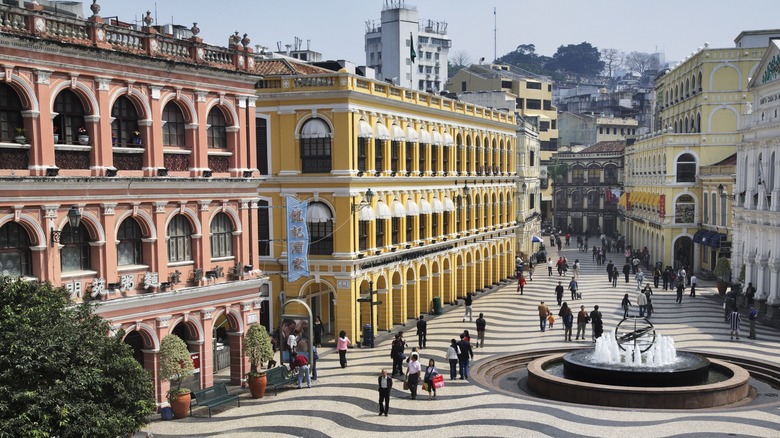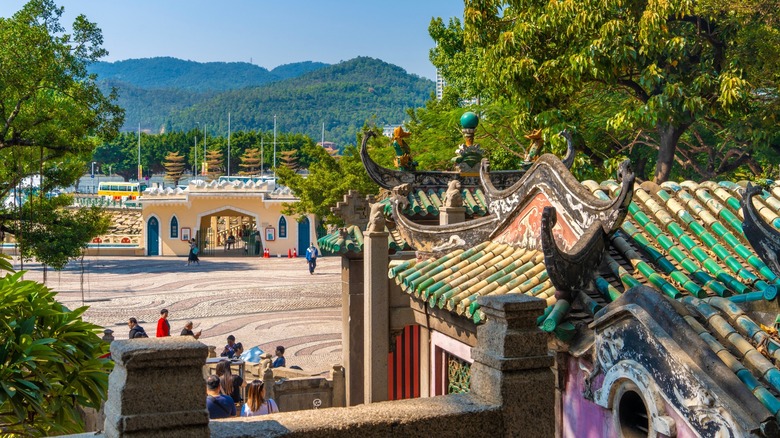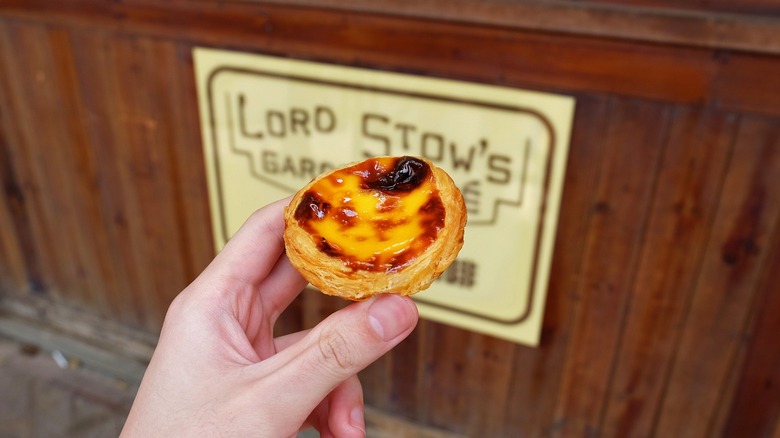The 'Las Vegas Of Asia' Is A Bustling Chinese City With Portuguese Culture And Architecture
Located on a tiny peninsula and island situated between three estuaries emptying into the South China Sea, Macao is a tiny Special Administrative Region (SAR) of China and one of the most densely populated cities in the world. The Macao peninsula, once a sleepy fishing village, was a port city along the Silk Road in ancient times. It became increasingly important for trade in the 16th century when Portuguese merchants, explorers, and missionaries began to settle there, eventually negotiating with the Chinese for administrative control of the peninsula and the Macao islands of Taipa and Coloane. Macao's international importance faded when the British took control of nearby Hong Kong, but the thriving East-West culture that was born there continued to flourish.
In 1999, Portugal ceded control of the city to China. They left behind colorful blue and yellow European buildings, the remains of a Catholic and Christian culture found nowhere else in China, and a casino industry that had been supplying Chinese mainlanders with a favorite vice for hundreds of years. The gambling industry was formally legalized by the Portuguese in 1847, and again by the Chinese government in 2002, when they granted the first casino licenses to the massive hotel-resort casinos of the Cotai Strip. Cotai, a modern addition to Macao, is a neighborhood consisting entirely of a reclaimed land mass that connects the ancient islands of Taipa and Coloane.
Today, the massive gambling industry –- which, by 2020, was bringing in three times the revenue of Las Vegas –- is the bright, artificial flavoring that overshadows the more simple pleasures of the original Chinese cultural landmarks that attracted the Portuguese. Even if you've been to the best Chinatowns in America, nothing can prepare you for the "real" Macao, which is still all over the peninsula and island. It's widely accessible, culturally unique, and just waiting to be explored.
Macao's east-west culture celebrates religious and cultural intersections
The Macao Peninsula's historic center includes 22 buildings that are collectively listed as a UNESCO World Heritage Site. The peninsula is connected to Macao Island by three bridges, and major resort hotels offer free buses that take tourists to and from their properties on the Cotai Strip and other sites on the main peninsula, which can save time and money.
Introduced by the locals to the temple of A-Ma, the peninsula's Daoist deity and protector of sailors, the Portuguese adopted the local temple name, A Ma Gao (place of A-ma), later rebranding it in their own language as "Macao." (It's currently spelled "Macau" in Portuguese and "Macao" in English.) Today, the A-Ma Temple (located in Barra Square next to Avenida Panoramica do Lago Sai Van, open 8 a.m. to 6 p.m.) is a complex with pavilions dedicated to A-Ma as well as other Daoist folk heroes and Confucian, Taoist, and Buddhist beliefs. From its highest point, it provides a great view over the river where you can imagine the Portuguese coming ashore.
Although the Cotai Strip contains replicas of the Eiffel Tower, Big Ben, and Venetian canals, the Moorish, Baroque, and neoclassical architecture of Macao's colonial times is a more modest European contribution. Three pastel-green governors' residences, built in 1921 and located just across a marshy pond from Cotai on Avenida da Praia, are collectively known as the Taipa Houses Museum. Today, they show different facets of colonial life on the island. In the historical center on the main peninsula, St. Dominic's Church (on St. Dominic's Square, open 10 a.m. until 6 p.m.) is one of the city's oldest, dating back to 1587. The church is still in operation and also houses a gallery of sacred art.
The variety of great eating options is astonishing
Much like neighboring Hong Kong's moveable feast of an island, Macao is a city that does not let the eyes go hungry, much less the stomach. Bold contrasts — busy-ness and simplicity, cream and crunch, fresh and pickled — define Macao, which has no less than 14 Michelin-starred restaurants and nine with the Michelin "Bib Gourmand" for affordable quality in cooking. Try the one-star Pear Dragon at Studio City (Shop 2111, level 2F, Star Tower, Estrada do Istmo, Cotai) to experience extraordinary Cantonese flavors and dozens of specialty Chinese teas (this is definitely not a teahouse scam). Meanwhile, Five Foot Road, on the ground floor of the MGM Cotai, offers a one-star Sichuan feast featuring carefully balanced spices and flavors of the region.
If you're looking for the street food, dim sum, or herbal medicine experience, check out Rua da Felicidade, a street in the peninsula's historical center that has transformed from a 19th-century opium-laden and brothel-rich avenue of "sinful pleasures" to a modern-day avenue of exceptional hole-in-the-wall finds. Belos Tempos (10 Rua da Felicidade, open 12 p.m. until 10 p.m. daily) blends Macanese creations and traditional Portuguese dishes in a cozy, traditional atmosphere. A Portuguese-English import, the pastel de nata has also been transformed by Chinese tastes into a less-sweet but very tasty egg tart. Popularized by the Englishman Andrew Stow when he opened an egg tart shop in 1989, the tarts have become one of the most popular desserts all over Macao as one of the Portuguese's most lasting and tasty culinary transplants.


